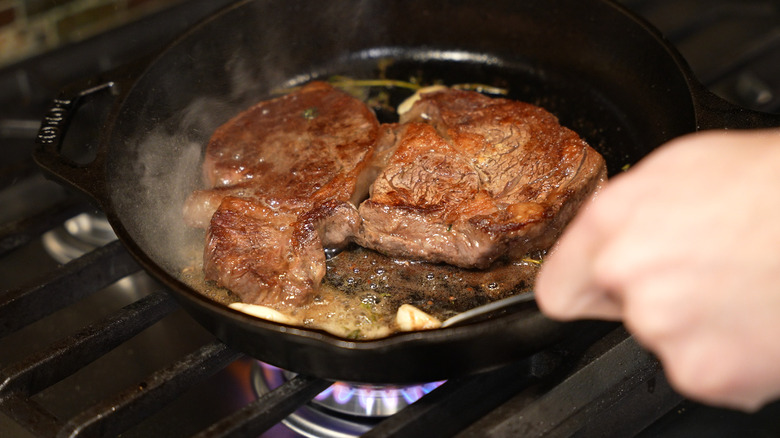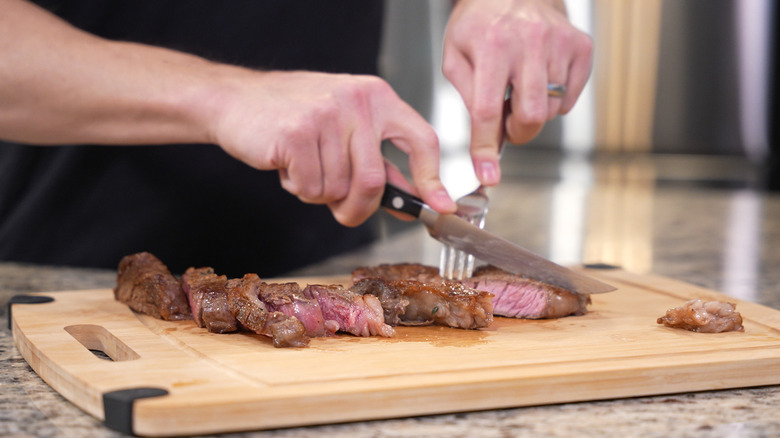How To Pan Sear Steak - You're Doing It All Wrong
A steak dinner isn't exactly the cheapest meal around, so if you're not cooking it right, it's a little like throwing money away. Pan-searing that steak might seem like a simple and intuitive way to cook that prime cut, but there's a surprising number of small tricks to getting it right, from the prep to the heat level you use.
But before you get your skillet out, you'll want to make sure you're starting on the right foot — this means choosing a cut that will sear well. You'll want a cut with a good amount of fat in it (so it doesn't dry out) that's around 1.5 inches thick. You can cook with thinner cuts like flank or hanger steaks, but it's a risky proposition, especially if you want your steak on the rare side, as they're much easier to overcook. Bone-in steaks like a T-bone are also tricky since the bone can keep the meat away from the surface of the pan, making a good sear difficult. Some good options are a New York strip steak, a ribeye, or a tenderloin. Also, pay attention to the marbling of your cut. If you choose a cut with subpar marbling or hardly any fat, it will become tough and chewy rather than juicy and delicious.
The most common pan-searing mistakes to avoid
If your skillet is hot to go and you're taking your steak directly from the refrigerator and dropping it into the pan, that's a big error. You want the pan to be super hot to ensure a nice brown sear and fridge-cold meat will cool it down on contact, making for a less-satisfying sear. It's better to take the steak out of the fridge and bring it up to room temperature for 20–30 minutes or sometimes even longer — the exact length of time will vary depending on how warm your kitchen is and how thick the steak is, but as long the meat isn't at fridge temperature, you're on the right track.
The second big mistake is at the other end of the cooking process. When the steak comes out of the pan, you'll want to let it rest again; this time for 5–7 minutes before you cut it open. This allows the juices to settle evenly throughout the steak after the cooking process has squeezed them all into the center. Cut it open too soon and you'll lose the juices and end up with a drier steak. Again, the timing varies, and some experts recommend 10 or more minutes for thicker cuts, but even a little rest for your cooked steak is better than none at all.
How to sear steak properly
To prep your steak make sure to pat it dry to remove any excess moisture, and make sure you're seasoning your steak. Don't be shy with the salt and pepper. When the steak is ready to cook, make sure your pan is preheated on high heat (ideally, you'll use a pan-like cast iron that can handle more intense heat). Thick cuts can be on slightly lower heat to make sure they cook enough but don't drop the heat anywhere towards medium: You want the oil to smoke a little. High heat is essential for a quick sear that'll lead to a nice firm crust.
The trickiest part of searing steak is getting the timing right, and if you're a novice, this may take practice. You'll want to cook your steak on both sides and consider checking it with a meat thermometer: a medium-rare steak should be 120 degrees Fahrenheit in the center when it's done, and 130 degrees for medium. A 1.5-inch steak should take around 2–4 minutes on each side to cook to medium but be warned that this timing is only approximate, so it pays to keep a very close eye on the pan.
After you've got a good sear on both sides, add a tablespoon of butter to the pan along with a few cloves of fresh garlic and sprigs of fresh thyme. Tilt your pan and use a spoon to baste the melted butter all over both sides of your steak. You can also spear a clove of garlic with a fork and rub it on your steak for more flavor. When the steak is cooked to your liking, pull it from the pan, let it rest, and there you have it: a perfectly pan-seared steak.

